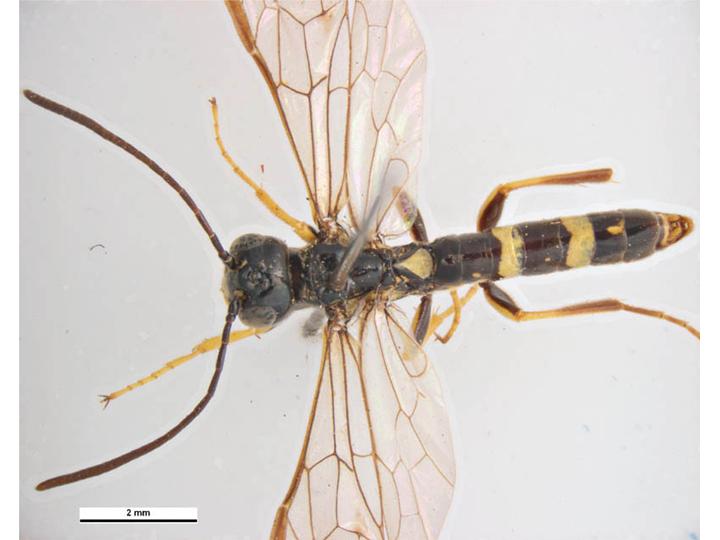Symptoms, description and lifecycle
Infested stems are filled with frass and are cleanly cut at the feeding site causing lodging. Larval feeding weakens the stems and destroys vascular tissue affecting nutrient transfer to the heads. Damage varies, depending on the year, locality, host plant and cultivar. Losses of up to 56 per cent in wheat and 50 per cent in barley have been recorded.
Adult wasps are black with prominent bright-yellow bands across the abdomen. Legs are yellow and wings are clear with brownish veins. Both species lay eggs in the stems of grasses.
Cephus pygmeus (alternative spelling pygmaeus) have a single generation per year laying a single egg per stem but up to 50 eggs per lifetime. Larvae feed within the stems of grasses, especially cereals. Early instars have a yellow-white body with an enlarged brown head, large mandibles and an anal tubercle. Mature instars become yellow-green. Larvae cut the stems to construct pupation chambers within the stem where they will pupate over winter affecting grain yield and quality. Adult European wheat stem sawfly (Image 26) are eight to ten millimetres long. Females are larger than males.
Cephus cinctus females produce 35 eggs on average which are laid within the stems of host plants. Larvae are white, segmented and legless, with tan head capsules and reach about 14 mm in length. Eggs are white, round and 1-1.5 mm in diameter. Larvae are white with tan head capsules and have a prominent caudal horn. Pupa are white, darkening as they become mature. Adults wheat stem sawflies are 7-12 mm long. Females are larger than males.
Organism
Cephus pygmeus (European wheat stem sawfly)
Cephus cinctus (Wheat stem sawfly)
Host range
Cephus pygmaeus is primarily a pest of cultivated grass crop species such as oats (Avena sativa), barley (Hordeum vulgare), rye (Secale cereale) and wheat (Triticum aestivum). Minor hosts include wild oats (Avena fatua), bromegrasses (Bromus), hoary cress (Lepidium draba) and timothies (Phleum).
Cephus cinctus infests barley, rye, wheat, and triticale. Non-crop hosts include wheatgrass (Agropyron), wildrye (Elymus), Phleum and Bromus. Oats and rice are resistant.
Methods of spread
This species can be spread as larvae within the stems of infected crops. Cereal straw, baled as hay or carried on machinery could potentially transport the pest over long distances. Adults are capable of flight for localised spread.
Confused with?
Adults could be confused with other small wasps. Lodging can occur for various reasons. Any larvae found within lodged stems (especially cleanly cut stems) should be investigated further.
Where?
The European wheat stem sawfly (C. pygmeus) occurs in Europe, North Asia, Canada, North America and Algeria in Africa.
The Wheat stem sawfly (C. cinctus) occurs in eastern Russia, Japan, in western parts of the United States and Canada. There are also reports of this species occurring in Kazakhstan.

Image 26. Adult European wheat stem sawfly. Source: Ken Walker, Museum Victoria.


